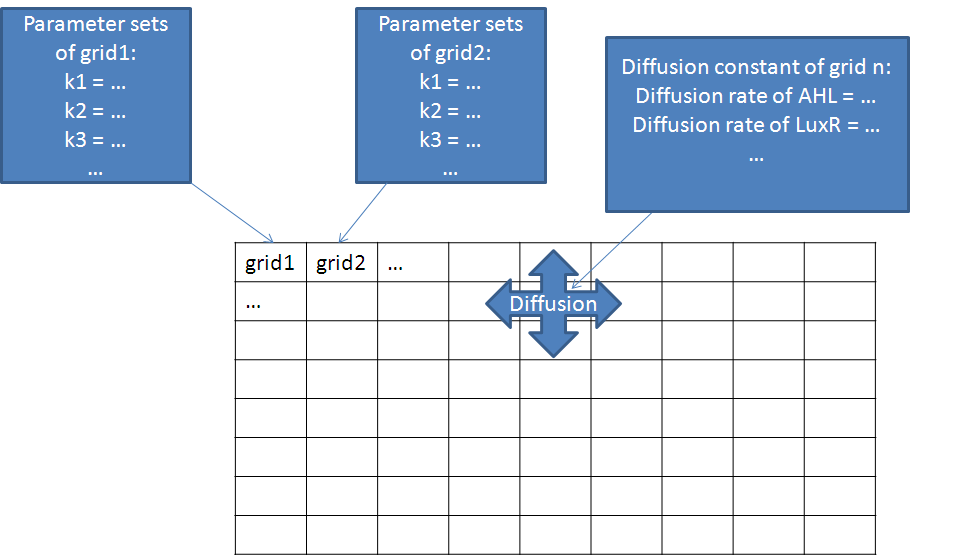Team:NTU-Taida/Modeling/2D Determinstic Model
From 2013.igem.org
(Created page with "{{:Team:NTU-Taida/Templates/Header}}{{:Team:NTU-Taida/Templates/Navbar}}{{:Team:NTU-Taida/Templates/Sidebar|Title=2D Deterministic Model}}{{:Team:NTU-Taida/Templates/ContentStart...") |
|||
| Line 2: | Line 2: | ||
=2D deterministic model= | =2D deterministic model= | ||
| - | + | If we construct the grids and simulate the simple model in each grid, and take the diffusion between grids into considerations, we can get 2D or 3D space models. | |
[[File:NTU-Taida-drylab-2.jpg|700px|thumb|center|]] | [[File:NTU-Taida-drylab-2.jpg|700px|thumb|center|]] | ||
| - | + | We can set different parameters in each grid to simulate different environments in 2D space. For example, set all rate constant (except diffusion constant) to zero to simulate the extracellular environment, or set the low diffusion constant to simulate the obstacle of diffusion in cell membrane. Hence we can define the extracellular/intracellular/cell membrane area by setting different rate or diffusion constant. | |
| - | + | The following movie is the simulation results of 100*100 grids which contains 100 cells (the size of each cell is 6*6 grids), we can observe the GFP is generated only in cytoplasm: | |
| - | + | Also we can observe the diffusion process of AHL: | |
| - | + | Finally to get the different behavior of each grid, we can set the random rate constant on them, then the molecules will not be uniformly distributed in the cytoplasm: | |
{{:Team:NTU-Taida/Templates/ContentEnd}}{{:Team:NTU-Taida/Templates/Footer|ActiveNavbar=Modeling}} | {{:Team:NTU-Taida/Templates/ContentEnd}}{{:Team:NTU-Taida/Templates/Footer|ActiveNavbar=Modeling}} | ||
Revision as of 13:47, 13 September 2013
2D deterministic model
If we construct the grids and simulate the simple model in each grid, and take the diffusion between grids into considerations, we can get 2D or 3D space models.
We can set different parameters in each grid to simulate different environments in 2D space. For example, set all rate constant (except diffusion constant) to zero to simulate the extracellular environment, or set the low diffusion constant to simulate the obstacle of diffusion in cell membrane. Hence we can define the extracellular/intracellular/cell membrane area by setting different rate or diffusion constant.
The following movie is the simulation results of 100*100 grids which contains 100 cells (the size of each cell is 6*6 grids), we can observe the GFP is generated only in cytoplasm:
Also we can observe the diffusion process of AHL:
Finally to get the different behavior of each grid, we can set the random rate constant on them, then the molecules will not be uniformly distributed in the cytoplasm:
 "
"



